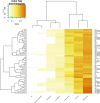Taste perception and oral microbiota are associated with obesity in children and adolescents
- PMID: 31509575
- PMCID: PMC6738620
- DOI: 10.1371/journal.pone.0221656
Taste perception and oral microbiota are associated with obesity in children and adolescents
Abstract
Obesity in childhood and adolescence is considered the most prevalent nutritional disorder, in which eating behaviours represent one important factors of influence. Many aspects influence eating behaviours, but taste is considered the main predictor. However, data concerning correlations of obesity, taste sensitivity and behavioural attitudes, such as food neophobia, in children and adolescents are inconsistent. Moreover, it has been suggested that oral bacteria could have a possible role in obesity development and, also, in taste perception. In this context, the present study focused on host related factors with a proposed link to weight gain. To this purpose, taste sensitivity, salivary microbiota composition and food neophobia were compared between children and adolescents with and without obesity in a cross-sectional study. Results showed that children with obesity presented a significantly lower ability in correctly identifying taste qualities and were characterized by a lesser number of Fungiform Papillae (reported as FP/cm2) compared to normal-weight subjects. Differences in the ecological indexes of microbial alpha-diversity was found between subjects with obesity and normal-weight ones. Moreover, independently from nutritional status, some bacterial genera seemed to differ between subjects with different sensitivity. The potentiality of this multidisciplinary approach could help to better understand and deepen the sensory-driven and microbiological factors related to weight gain.
Conflict of interest statement
The authors have declared that no competing interests exist.
Figures






Similar articles
-
Alteration of taste perception, food neophobia and oral microbiota composition in children with food allergy.Sci Rep. 2023 Apr 28;13(1):7010. doi: 10.1038/s41598-023-34113-y. Sci Rep. 2023. PMID: 37117251 Free PMC article.
-
Associations Among Taste Perception, Food Neophobia and Preferences in Type 1 Diabetes Children and Adolescents: A Cross-Sectional Study.Nutrients. 2019 Dec 13;11(12):3052. doi: 10.3390/nu11123052. Nutrients. 2019. PMID: 31847252 Free PMC article.
-
Identification of an oral microbiota signature associated with an impaired orosensory perception of lipids in insulin-resistant patients.Acta Diabetol. 2020 Dec;57(12):1445-1451. doi: 10.1007/s00592-020-01567-9. Epub 2020 Jul 16. Acta Diabetol. 2020. PMID: 32676702 Free PMC article.
-
Is oral microbiota associated with overweight and obesity in children and adolescents? A systematic review.Crit Rev Food Sci Nutr. 2024;64(13):4275-4285. doi: 10.1080/10408398.2022.2140330. Epub 2022 Nov 3. Crit Rev Food Sci Nutr. 2024. PMID: 36419361
-
Biological films adhering to the oral soft tissues: Structure, composition, and potential impact on taste perception.J Texture Stud. 2019 Feb;50(1):19-26. doi: 10.1111/jtxs.12363. Epub 2018 Oct 1. J Texture Stud. 2019. PMID: 30226267 Review.
Cited by
-
No ambiguity: Chemosensory-based ayurvedic classification of medicinal plants can be fingerprinted using E-tongue coupled with multivariate statistical analysis.Front Pharmacol. 2022 Dec 2;13:1025591. doi: 10.3389/fphar.2022.1025591. eCollection 2022. Front Pharmacol. 2022. PMID: 36532778 Free PMC article.
-
Effects of Habitat River Microbiome on the Symbiotic Microbiota and Multi-Organ Gene Expression of Captive-Bred Chinese Giant Salamander.Front Microbiol. 2022 Jun 13;13:884880. doi: 10.3389/fmicb.2022.884880. eCollection 2022. Front Microbiol. 2022. PMID: 35770173 Free PMC article.
-
Impact on Fecal Microbiota and Health-Related Markers of an Intervention Focused on Improving Eating Behavior in People at Risk of Food Insecurity.Nutrients. 2023 Aug 11;15(16):3537. doi: 10.3390/nu15163537. Nutrients. 2023. PMID: 37630728 Free PMC article.
-
Alteration of taste perception, food neophobia and oral microbiota composition in children with food allergy.Sci Rep. 2023 Apr 28;13(1):7010. doi: 10.1038/s41598-023-34113-y. Sci Rep. 2023. PMID: 37117251 Free PMC article.
-
Differential effects of high-fat diet on salivary and gut microbiota.Front Cell Infect Microbiol. 2025 Feb 24;15:1547555. doi: 10.3389/fcimb.2025.1547555. eCollection 2025. Front Cell Infect Microbiol. 2025. PMID: 40066066 Free PMC article.

